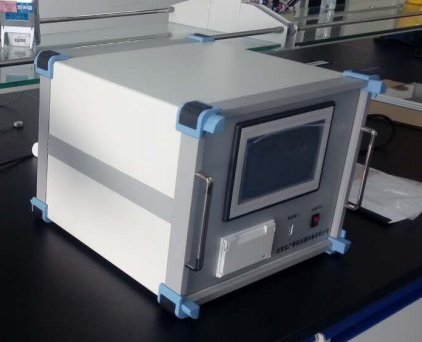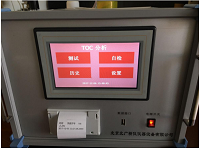
纯水纯化水TOC分析仪 更换UV 灯
更换UV 灯时,须小心操作,以免损坏灯管及其周围的螺旋状石英管。
给客户提供新UV 灯管时,附送一双手套供安装时使用,避免在 UV 灯管表面和螺
旋状石英管表面留下指纹。指纹会吸收UV 光线、降低氧化反应器的氧化性能。同时
在安装新的UV 灯管之前可以使用乙醇去除指纹和污垢,保证 UV 灯表面的透光率。
纯水纯化水TOC分析仪 更换UV 灯具体操作:
○1 关闭主电源开关,拔去电源线。
○2 将仪器机箱后盖板的螺钉拧开,打开后盖板。
○3 拔掉连接灯管的电源线插头,并柠松灯管座的锁紧螺母,慢慢抽出灯管。
○4 换上新灯管并调整灯管在螺旋石英管中的有效位置,拧紧锁紧螺母。
○5 插好灯管的电源线插头并将机箱后盖板螺丝拧紧,更换结束。
更换以上部件时存在问题可联系仪器厂家解决。
纯水纯化水TOC分析仪 工作原理
本仪器采用紫外氧化的原理,将样品中的有机物氧化为二氧化碳,二氧化碳的测试采用的是直接电导率法,通过测试经过氧化反应的样品的总碳含量和未经过氧化反应的样品总无机碳的含量差值来测定总有机碳含量,即:总有机碳(TOC)=总碳(TC)-总无机碳(TIC)。
产品特点
1.仪器采用便携设计,使用轻便,方便移动至取样点。
2.采用嵌入式系统,触摸屏设计,纯中文操作方便简易。
3.针对制药用水(TOC含量在1000ppb以下)总有机碳含量的检测设计,进行检测。
4.配备大量的储存空间,能够存储大量的测试数据。
5.中文打印,输出测试参数、测试结果。
6.在使用、贮存和更换过程中不需要气体或试剂,无移动部件,减少维修和维护成本。
7.当测试样品浓度超过规定限度,仪器能够自动报警,并输出控制信号。
8.符合国家2010版《中国药典》规定的测试方案,可以提供IQ/OQ/PQ服务。
产品特点
1.仪器采用便携设计,使用轻便,方便移动至取样点。
2.采用嵌入式系统,触摸屏设计,纯中文操作方便简易。
3.针对制药用水(TOC含量在1000ppb以下)总有机碳含量的检测设计,进行检测。
4.配备大量的储存空间,能够存储大量的测试数据。
5.中文打印,输出测试参数、测试结果。
6.在使用、贮存和更换过程中不需要气体或试剂,无移动部件,减少维修和维护成本。
7.当测试样品浓度超过规定限度,仪器能够自动报警,并输出控制信号。
8.符合国家《中国药典》 CP2010规定的测试方案,可以提供IQ/OQ/PQ服务。
性能规格:
测量范围:0.01mg/L~1.000 mg/L(此处可调)
精度:?4%测试范围
分辨率:0.001mg /L
分析时间:连续分析
响应时间:6分钟之内
检测极限:0.001mg /L
样品温度:1- 95℃
重复性误差:≤3%
电源要求/功能:220V
显示屏:彩色触摸屏
操作控制:无线蓝牙技术;
主要特征:
1、高精度、高灵敏度,操作简单。
2、人性化操作界面,有一键运行功能,自动管路清洗功能。
3、高性能CPU,触摸屏设计,超大640*480点阵真彩显示器。
4、不用拆开机箱更换UV灯和泵管。
5、检测上限可设定,自动上限报警功能。
6、具有RS232数据接口,历史数据可存储6个月。
7、离线检测和在线检测可选配。
8、具有打印功能
系统组成
TOC分析仪的组成包括以下7个主要部分:
① 在线检测装置(在线型仪器配备)
② 样品蠕动泵
③ 分流器
④ 氧化反应器
⑤ 二氧化碳传感器
⑥ 微处理控制器和电子线路板
⑦ 输出接口
主要配置
主机 一台
触摸屏 (镶嵌到仪器中)
微型打印机 一台
进样管 一条
电源线 一套
产品说明书 一份
产品合格证 一份
产品装箱单 一份
参数:
1 | 测量范围 | 0.01mg/L~1.000 mg/L |
2 | 精度 | ?4% |
3 | 分辨率 | 0.001mg /L |
4 | 分析时间 | 40分钟 |
5 | 响应时间 | 8分钟 |
6 | 检测极限 | 0.001mg /L |
7 | 样品温度 | 1- 95℃ |
8 | 电源要求/功能 | 220V |
9 | 重复性误差 | ≤3% |
10 | 显示屏 | 彩色触摸屏 |
测定原理
总有机碳(TOC),由专门的仪器——总有机碳分析仪(以下简称TOC分析仪)来测定。TOC分析仪,是将水溶液中的总有机碳氧化为二氧化碳,并且测定其含量。利用二氧化碳与总有机碳之间碳含量的对应关系,从而对水溶液中总有机碳进行定量测定。
市面上常见的TOC分析仪都有两大基本功能:第一,首先将水中的总有机碳充分氧化,生成二氧化碳CO2;第二,测试新产生的CO2.不同品牌和型号的TOC分析仪的区别在于实现这两大基本功能的方法不同。常用的氧化技术有:燃烧氧化法、紫外线氧化法以及超临界氧化法;而对CO2的检测方法又分:非分散红外线检测,直接电导率检测以及选择性薄膜电导率检测。
紫外线氧化法
使用UV灯照射待测水样,水会分解成羟基和氢基,羟基和氧化物结合会生成CO2和水,然后检测新生成的CO2即可计算出总有机碳含量。在使用紫外线氧化法时,通过添加二氧化钛,过硫酸盐等可以提高氧化能力。紫外线氧化法的优点是氧化效率高,保养简单,缺点是UV灯管需要定期更换。
薄膜电导率检测法
的主要有两种电导率检测技术:一种是直接电导率法,另外一种是薄膜电导率检测法(又称选择性电导率法)。采用两种电导率法的TOC分析仪校验结果都很稳定,检测精度高。这两种技术最主要的区别在于,直接电导率法比较容易受杂酸性,卤化有机物等的干扰;而薄膜电导率检测技术抗干扰性更佳。
薄膜电导率检测法是GE TOC分析仪使用较多的检测方法,TOC分析仪使用的膜能防止杂离子的通过,确保检测的只是CO2的含量,从而使TOC的读数更为精确。
主要特征:
1、高精度、高灵敏度,操作简单。
2、人性化操作界面,有一键运行功能,自动管路清洗功能。
3、高性能CPU,触摸屏设计,超大640*480点阵真彩显示器。
4、不用拆开机箱更换UV灯和泵管。
5、检测上限可设定,自动上限报警功能。
6、具有RS232数据接口,历史数据可存储6个月。
7、离线检测和在线检测可选配。
8、具有打印功能
Replace UV lamp
When replacing the UV lamp, be careful to avoid damaging the lamp tube and the spiral quartz tube around it.
When providing new UV lamps to customers, a pair of gloves are included for installation to avoid contact with the surface and screws of the UV lamps
Fingerprints are left on the surface of the spiral quartz tube. Fingerprints absorb UV light and reduce the oxidation performance of the oxidation reactor. At the same time
Before installing a new UV lamp, ethanol can be used to remove fingerprints and dirt, ensuring the surface transmittance of the UV lamp.
Specific steps for replacing the UV lamp:
Turn off the main power switch and unplug the power cord.
Unscrew the screws on the back cover of the instrument case and open the back cover.
Disconnect the power cord plug connected to the lamp tube, loosen the locking nut of the lamp tube holder, and slowly pull out the lamp tube.
Replace the lamp tube with a new one and adjust its effective position in the spiral quartz tube, then tighten the locking nut.
Insert the power cord plug of the lamp tube and tighten the screws on the back cover of the chassis. The replacement is complete.
If there are any problems when replacing the above components, please contact the instrument manufacturer for resolution.
working principle
This instrument adopts the principle of ultraviolet oxidation to oxidize organic matter in the sample into carbon dioxide. The direct conductivity method is used to test the carbon dioxide content. The total organic carbon content is determined by measuring the difference between the total carbon content of the sample that has undergone oxidation reaction and the total inorganic carbon content of the sample that has not undergone oxidation reaction, that is, total organic carbon (TOC)=total carbon (TC) - total inorganic carbon (TIC).
Product Features
1. The instrument adopts a portable design, which is easy to use and convenient to move to the sampling point.
2. Adopting an embedded system and touch screen design, pure Chinese operation is convenient and easy.
3. Design and conduct testing for the total organic carbon content of pharmaceutical water (TOC content below 1000ppb).
4. Equipped with a large amount of storage space, capable of storing a large amount of test data.
5. Print in Chinese and output test parameters and results.
6. No gas or reagents are required during use, storage, and replacement, and there are no moving parts, reducing maintenance and repair costs.
When the concentration of the test sample exceeds the specified limit, the instrument can automatically sound an alarm and output a control signal.
8. According to the testing plan specified in the 2010 edition of the Chinese Pharmacopoeia, IQ/OQ/PQ services can be provided.
Product Features
1. The instrument adopts a portable design, which is easy to use and convenient to move to the sampling point.
2. Adopting an embedded system and touch screen design, pure Chinese operation is convenient and easy.
3. Design and conduct testing for the total organic carbon content of pharmaceutical water (TOC content below 1000ppb).
4. Equipped with a large amount of storage space, capable of storing a large amount of test data.
5. Print in Chinese and output test parameters and results.
6. No gas or reagents are required during use, storage, and replacement, and there are no moving parts, reducing maintenance and repair costs.
When the concentration of the test sample exceeds the specified limit, the instrument can automatically sound an alarm and output a control signal.
8. According to the testing plan specified in the Chinese Pharmacopoeia CP2010, IQ/OQ/PQ services can be provided.
Performance specifications:
Measurement range: 0.01mg/L to 1.000 mg/L (adjustable here)
Accuracy:?4% Test range
Resolution: 0.001mg/L
Analysis time: continuous analysis
Response time: within 6 minutes
Detection limit: 0.001mg/L
Sample temperature: 1-95℃
Repetitive error:≤3%
Power requirement/function: 220V
Display screen: Color touch screen
Operation control: wireless Bluetooth technology;
Main features:
1. High precision, high sensitivity, and easy operation.
2. Humanized operation interface, with one click operation function and automatic pipeline cleaning function.
3. High performance CPU, touch screen design, ultra large 640 * 480 dot matrix true color display.
4. No need to open the chassis to replace the UV lamp and pump tube.
5. The detection upper limit can be set, and the automatic upper limit alarm function.
6. Equipped with RS232 data interface, historical data can be stored for 6 months.
7. Offline detection and online detection are optional.
8. Equipped with printing function
system composition
The composition of TOC analyzer includes the following 7 main parts:
①Online detection device (equipped with online instruments)
②Sample peristaltic pump
③Diverter
④Oxidation reactor
⑤Carbon dioxide sensor
⑥Microprocessor controllers and electronic circuit boards
⑦Output interface
Main configuration
One host
Touch screen (embedded in the instrument)
One micro printer
One injection tube
A set of power cords
One copy of product manual
One copy of product qualification certificate
Product packing list copy
Parameters:
Measurement range: 0.01mg/L to 1.000mg/L
2 accuracy?4%
3 Resolution 0.001mg/L
4 analysis time 40 minutes
5 response time 8 minutes
6 detection limit 0.001mg/L
Sample temperature: 1-95℃
8 Power Requirements/Function 220V
9. Repetitive error≤3%
10 color touch screen display
Measurement principle
Total Organic Carbon (TOC) is measured by a specialized instrument called Total Organic Carbon Analyzer (TOC Analyzer). TOC analyzer is used to oxidize total organic carbon in aqueous solution to carbon dioxide and determine its content. Quantitative determination of total organic carbon in aqueous solution by utilizing the corresponding relationship between carbon content of carbon dioxide and total organic carbon.
The common TOC analyzers on the market have two basic functions: firstly, to fully oxidize the total organic carbon in water and generate carbon dioxide (CO2); Secondly, testing the newly generated CO2. The difference between TOC analyzers of different brands and models lies in the different methods used to implement these two basic functions. The commonly used oxidation techniques include combustion oxidation, ultraviolet oxidation, and supercritical oxidation; The detection methods for CO2 are divided into non dispersive infrared detection, direct conductivity detection, and selective thin film conductivity detection.
UV oxidation method
Using a UV lamp to irradiate the water sample to be tested, the water will decompose into hydroxyl and hydrogen groups. The combination of hydroxyl and oxide will generate CO2 and water, and then the newly generated CO2 can be detected to calculate the total organic carbon content. When using ultraviolet oxidation method, the oxidation ability can be improved by adding titanium dioxide, persulfate, etc. The advantages of UV oxidation method are high oxidation efficiency and simple maintenance, but the disadvantage is that UV lamps need to be replaced regularly.
Thin film conductivity detection method
There are two main conductivity detection techniques: direct conductivity method and thin film conductivity detection method (also known as selective conductivity method). The calibration results of TOC analyzers using two conductivity methods are both stable and have high detection accuracy. The main difference between these two technologies is that the direct conductivity method is more susceptible to interference from impurities such as acidity and halogenated organic compounds; The thin film conductivity detection technology has better anti-interference performance.
The thin film conductivity detection method is a commonly used detection method for GE TOC analyzers. The membrane used in TOC analyzers can prevent the passage of impurities, ensuring that only CO2 content is detected, thereby making TOC readings more accurate.
Main features:
1. High precision, high sensitivity, and easy operation.
2. Humanized operation interface, with one click operation function and automatic pipeline cleaning function.
3. High performance CPU, touch screen design, ultra large 640 * 480 dot matrix true color display.
4. No need to open the chassis to replace the UV lamp and pump tube.
5. The detection upper limit can be set, and the automatic upper limit alarm function.
6. Equipped with RS232 data interface, historical data can be stored for 6 months.
7. Offline detection and online detection are optional.
8. Equipped with printing function